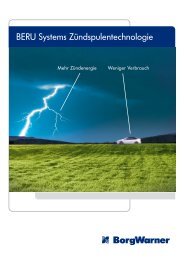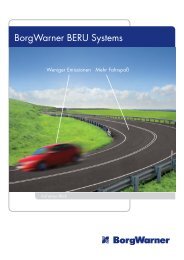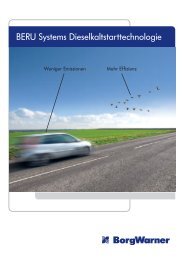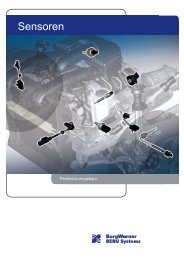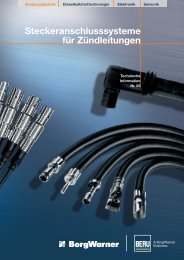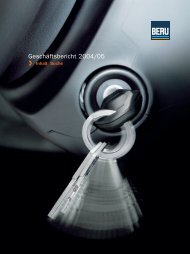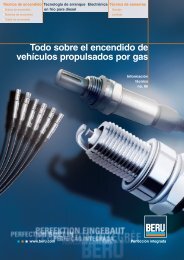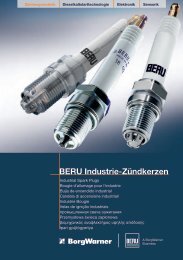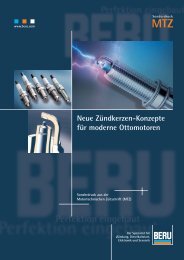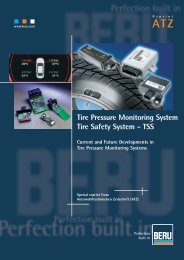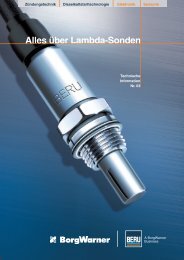Influence of modern diesel cold start systems on the cold start, warm ...
Influence of modern diesel cold start systems on the cold start, warm ...
Influence of modern diesel cold start systems on the cold start, warm ...
- TAGS
- diesel
- www.beru.com
You also want an ePaper? Increase the reach of your titles
YUMPU automatically turns print PDFs into web optimized ePapers that Google loves.
<str<strong>on</strong>g>Influence</str<strong>on</strong>g> <str<strong>on</strong>g>of</str<strong>on</strong>g> <str<strong>on</strong>g>modern</str<strong>on</strong>g> <str<strong>on</strong>g>diesel</str<strong>on</strong>g> <str<strong>on</strong>g>cold</str<strong>on</strong>g> <str<strong>on</strong>g>start</str<strong>on</strong>g> <str<strong>on</strong>g>systems</str<strong>on</strong>g> <strong>on</strong> <strong>the</strong> <str<strong>on</strong>g>cold</str<strong>on</strong>g> <str<strong>on</strong>g>start</str<strong>on</strong>g>, <strong>warm</strong>-up and emissi<strong>on</strong>s <str<strong>on</strong>g>of</str<strong>on</strong>g> <str<strong>on</strong>g>diesel</str<strong>on</strong>g> engines<br />
3 Evaluati<strong>on</strong> methods for <strong>the</strong> quality <str<strong>on</strong>g>of</str<strong>on</strong>g> <str<strong>on</strong>g>cold</str<strong>on</strong>g> <str<strong>on</strong>g>start</str<strong>on</strong>g>,<br />
engine <strong>warm</strong>-up and emissi<strong>on</strong>s<br />
The following chapter describes how <strong>the</strong> quality <str<strong>on</strong>g>of</str<strong>on</strong>g> <str<strong>on</strong>g>cold</str<strong>on</strong>g> <str<strong>on</strong>g>start</str<strong>on</strong>g>, engine <strong>warm</strong>-up and emissi<strong>on</strong>s<br />
are evaluated. Table 3.1 gives an overview about <strong>the</strong> evaluati<strong>on</strong> methods.<br />
In recent emissi<strong>on</strong> regulati<strong>on</strong>s [3] for <str<strong>on</strong>g>diesel</str<strong>on</strong>g> engines no regulati<strong>on</strong>s for <str<strong>on</strong>g>cold</str<strong>on</strong>g> <str<strong>on</strong>g>start</str<strong>on</strong>g>s below 0°C<br />
can be found. On <strong>the</strong> o<strong>the</strong>r side <strong>the</strong> <str<strong>on</strong>g>cold</str<strong>on</strong>g> <str<strong>on</strong>g>start</str<strong>on</strong>g> quality can be measured objectively. Therefore<br />
<strong>the</strong> criteria emissi<strong>on</strong>s, <str<strong>on</strong>g>start</str<strong>on</strong>g>ing time, combusti<strong>on</strong> quality and engine speed stability are used.<br />
Fur<strong>the</strong>rmore subjective criteria <str<strong>on</strong>g>of</str<strong>on</strong>g> <strong>the</strong> driver can be taken under c<strong>on</strong>siderati<strong>on</strong>. These are typically<br />
comfort criteria like noise, vibrati<strong>on</strong>, exhaust odor, visible emissi<strong>on</strong>s, <strong>the</strong> <str<strong>on</strong>g>start</str<strong>on</strong>g>ing time<br />
itself and last but not least <strong>the</strong> instant transient reacti<strong>on</strong> [4].<br />
Table 3.1 Evaluati<strong>on</strong> criteria for <str<strong>on</strong>g>cold</str<strong>on</strong>g> <str<strong>on</strong>g>start</str<strong>on</strong>g>, <strong>warm</strong>-up and emissi<strong>on</strong>s<br />
Chapter Evaluati<strong>on</strong> Criteria Cold Start Warm-up Emissi<strong>on</strong>s<br />
3.1 Starting time X<br />
3.2<br />
Indicated mean effective pressure X X<br />
Number <str<strong>on</strong>g>of</str<strong>on</strong>g> misfires X X<br />
3.3 Engine speed stability X<br />
3.4<br />
HC-Emissi<strong>on</strong> X<br />
CO-Emissi<strong>on</strong> X<br />
NOx-Emissi<strong>on</strong> X<br />
Opacity X<br />
3.1 Starting time<br />
In this paper <strong>the</strong> <str<strong>on</strong>g>start</str<strong>on</strong>g>ing time is defined as <strong>the</strong> time between <strong>the</strong> first voltage drop during<br />
cranking and <strong>the</strong> engine reaching a defined engine speed <str<strong>on</strong>g>of</str<strong>on</strong>g> 1000 rpm. The <str<strong>on</strong>g>start</str<strong>on</strong>g>ing time allows<br />
a validati<strong>on</strong> <str<strong>on</strong>g>of</str<strong>on</strong>g> <strong>the</strong> optimizati<strong>on</strong> degree <str<strong>on</strong>g>of</str<strong>on</strong>g> all parameters and influence values during <strong>the</strong> <str<strong>on</strong>g>cold</str<strong>on</strong>g><br />
<str<strong>on</strong>g>start</str<strong>on</strong>g>.<br />
3.2 Pressure indicati<strong>on</strong><br />
By m<strong>on</strong>itoring <strong>the</strong> cylinder pressure informati<strong>on</strong> it is possible to calculate <strong>the</strong>rmodynamic<br />
values in <strong>the</strong> combusti<strong>on</strong> chamber. The pressure is measured over crank angle. In order to<br />
evaluate <str<strong>on</strong>g>cold</str<strong>on</strong>g> <str<strong>on</strong>g>start</str<strong>on</strong>g> and <strong>warm</strong>-up qualities values like standard deviati<strong>on</strong> <str<strong>on</strong>g>of</str<strong>on</strong>g> <strong>the</strong> indicated mean<br />
effective pressure and misfire detecti<strong>on</strong> are typically used.<br />
With pressure sensor glow plugs, such as <strong>the</strong> BERU PSG, it is possible to measure <strong>the</strong> cylinder<br />
pressure in series applicati<strong>on</strong>s. The calculati<strong>on</strong> and evaluati<strong>on</strong> <str<strong>on</strong>g>of</str<strong>on</strong>g> <strong>the</strong> menti<strong>on</strong>ed values could<br />
5



